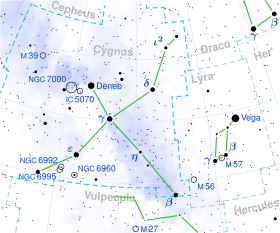Chi Cygni
| Observation data Epoch J2000 Equinox J2000 |
|
|---|---|
| Constellation | Cygnus |
| Right ascension | 19h 50m 33.92439s |
| Declination | +32° 54′ 50.6097″ |
| Apparent magnitude (V) | 3.3 – 14.2 |
| Characteristics | |
| Spectral type | S6+/1e = MS6+(S6,2e – S10,4e) |
| U−B color index | −0.30 – +0.98 |
| B−V color index | +1.56 – +2.05 |
| Variable type | Mira |
| Astrometry | |
| Radial velocity (Rv) | +1.60 km/s |
| Proper motion (μ) |
RA: -20.16 mas/yr Dec.: -38.34 mas/yr |
| Parallax (π) | 5.53 ± 1.10mas |
| Distance | 553 ly (169pc) |
| Absolute magnitude (MV) | −3.2 – +7.7 |
| Details | |
| Mass |
2.1+1.5 −0.7 M☉ |
| Radius | 348 – 480 R☉ |
| Luminosity | 6,000 – 9,000 L☉ |
| Temperature | 2,441 – 2,742 K |
| Other designations | |
| Database references | |
| SIMBAD | data |
Chi Cygni (χ Cyg, χ Cygni) is a variable star of the Mira type in the constellation Cygnus, and also an S-type star. Its apparent visual magnitude varies from as bright as 3.3 to as faint as 14.2.
Flamsteed recorded that his star 17 Cygni was Bayer's χ Cygni. It is assumed that χ was not visible at that time, but there is no further information and the discrepancy was not noticed until 1816. Bayer had recorded χ Cygni as a 4th magnitude star, presumably near maximum brightness.
The astronomer Gottfried Kirch discovered the variability of χ Cygni in 1686. While researching that area of the sky for observations of Nova Vulpeculae, he noted that the star marked as χ in Bayer's Uranometria atlas was missing. He continued to monitor the area and on October 19, 1686 he recorded it at 5th magnitude.
Kirch regarded χ Cyg as a regular variable with a period of 404.5 days, but it was quickly noted that both the period and amplitude varied considerably from cycle to cycle. Thomas Dick, LL.D, writes:
The star was then observed only sporadically until the 19th century. A continuous sequence of observations were made by Argelander and Schmidt from 1845 to 1884. These were the first series of observations showing the minima of the light variations. Since the start of the 20th century, it has been monitored closely by multiple observers.
The earliest spectra of χ Cygni could only be taken near maximum light. They show weak absorption lines, with bright emission lines superimposed, and it was typically classified as around M6e at maximum brightness. After the S class was introduced, χ Cygni was considered intermediate between class M and class S, for example either S5e or M6-M8e. Later more sensitive spectra near minimum gave spectral types as late as M10 or S10,1e. Under the revised classification system for S stars, designed to better reflect the gradation between M stars and carbon stars, χ Cygni at normal maximum was classified as S6 Zr2 Ti6 or S6+/1e, considered equivalent to MS6+. Spectral types at different phases of variation ranged from S6/1e to S9/1-e although no measurements were taken at minimum brightness.
...
Wikipedia

